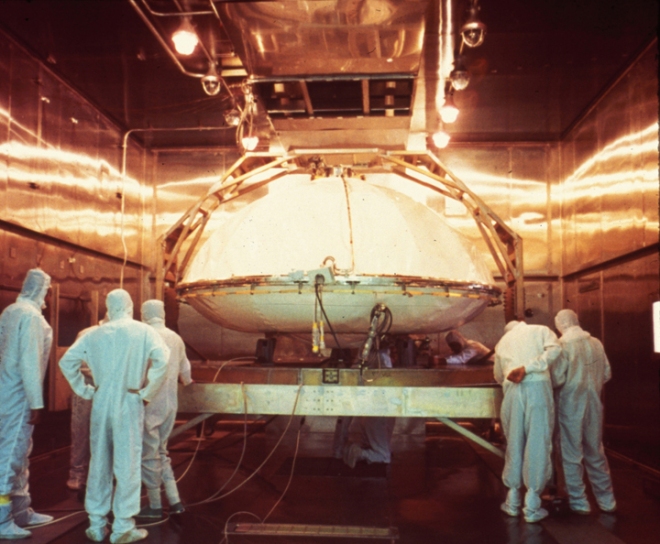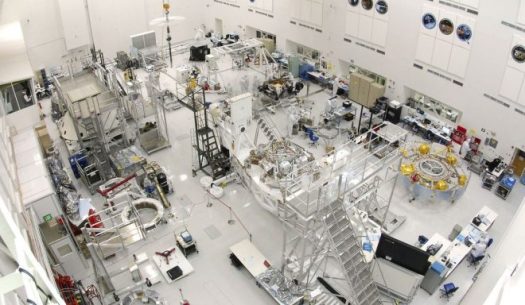
The only time that a formally designated NASA “life detection” mission was flown to another planet or moon was when the two Viking landers headed to Mars forty years ago.
The odds of finding some kind of Martian life seemed so promising at the time that there was little dispute about how much energy, money and care should be allocated to making sure the capsule would not be carrying any Earth life to the planet. And so after the two landers had been assembled, they were baked at more than 250 °F for three days to sterilize any parts that would come into contact with Mars.
Although the two landers successfully touched down on the Martian surface and did some impressive science, the life detection portion of the mission was something of a fiasco — with conflict, controversy and ultimately quite a bit of confusion.
Clearly, scientists did not yet know enough about how to search for life beyond Earth and the confounding results pretty much eliminated life-detection from NASA’s missions for decades.
But scientific and technological advances of the last ten years have put life detection squarely back on the agenda — in terms of future searches for fossil biosignatures on Mars and for potential life surviving in the oceans of Europa and Enceladus. What’s more, both NASA and private space companies talk seriously of sending humans to Mars in the not-too-distant future.
With so many missions being planned, developed and proposed for solar system planets and moons, the issue of planetary protection has also gained a higher profile. It seems to have become more contentious and to some seems far less straight-forward as it used to be.
A broad consensus appears to remain that bringing Earth life to another planet or moon, especially if it is potentially habitable, is a real possibility that is both scientifically and ethically fraught. But there are rumblings about just how much time, money and attention needs to be brought to satisfying the requirements of “planetary protection.”
In fact, it has become a sufficiently significant question that the first plenary session of the recent Astrobiology Science Conference in Mesa, Arizona was dedicated to it. The issue, which was taken up in later technical sessions as well, was how to assess and weigh the risks of bringing Earth life to other bodies versus the benefits of potentially sending out more missions, more often and more cheaply.
It is not a simple problem, explained Andrew Maynard, director of the Risk Innovation Lab at Arizona State University. Indeed, he told the audience of scientists that it was a “wicked problem,” a broadly used terms for issues that are especially complex and involve numerous issues and players.

As he later elaborated to me, other “wicked” risk-benefit problems include gene editing and autonomous driving — both filled with great potential and serious potential downsides. Like travel to other planets and moons.
“This is subjective,” Maynard said, “but I’d put planetary protection on the more wicked end of the spectrum. It combines individual priorities and ethics — what people and groups deeply believe is right — with huge uncertainties. That makes it something never really experienced before and so escalates all factors of wickedness.”
Those groups include scientists (who very much don’t want Mars or another potentially habitable place to be contaminated with Earth life before they can get there), to advocates of greater space exploration (who worry that planetary protection will slow or eliminate some missions they very much want to proceed), to NASA mission managers (worried about delays and costs associated with planetary protections surprises.)
And then there’s the general public which might (or might not) have entirely different ethical concerns about the potential for contaminating other planets and moons with Earth life.
No wonder the problem is deemed wicked.
We’ll get into the pros and cons, but first some background:
I asked NASA’s Planetary Protection officer, Catharine Conley, whether Earth life has been transported to its most likely solar system destination, Mars.
Her reply: “There are definitely Earth organisms that we’ve brought to Mars and are still alive on the spacecraft.”

She said it is quite possible that some of those organisms were brushed off the vehicles or otherwise were shed and fell to the surface. Because of the strong ultraviolet radiation and the Earth life-destroying chemical makeup of the soil, however, it’s unlikely the organisms could last for long, and equally unlikely that any would have made it below the surface. Nonetheless, it is sobering to hear that Earth life has already made it to Mars.
Related to this reality is the understanding that Earth life, in the form of bacteria, algae and fungi and their spores, can be extraordinarily resilient. Organisms have been discovered that can survive unimagined extremes of heat and cold, can withstand radiation that would kill us, and can survive as dormant spores for tens of thousands of years.
What’s more, Mars scientists now know that the planet was once much warmer and wetter, and that ice underlies substantial portions of the planet. There are even signs today of seasonal runs of what some scientists argue is very briny surface water.
So the risk of Earth life surviving a ride to another planet or moon is probably greater than imagined earlier, and the possibility of that Earth life potentially surviving and spreading on a distant surface (think the oceans of Europa and Enceladus, or maybe a briny, moist hideaway on Mars) is arguably greater too. From a planetary protection perspective, all of this is worrisome.
The logic of planetary protection is, like almost everything involved with the subject, based on probabilities. Discussed as far back as the 1950s and formalized in the 1967 Outer Space Treaty, the standard agreed on is to take steps that ensure there is less than a 1 in 10,000 chance of a spaceship or lander or instrument from Earth bringing life to another body.
This figure takes into account the number of microorganisms on the spacecraft, the probability of growth on the planet or moon where the mission is headed, and a series of potential sanitizing to sterilizing procedures that can be used. A formula for assessing the risk of a mission for planetary protection purposes was worked out in 1965 by Carl Sagan, along with Harvard theoretical physicist Sidney Coleman.

A lot has been learned since that time, and some in the field say it’s time to re-address the basics of planetary protection. They argue, for instance, that since we now know that Earth life can (theoretically, at least) be carried inside a meteorite from our planet to Mars, then Earth life may have long been on Mars — if it is robust enough to survive when it lands.
In addition, a great deal more is known about how to sanitize a space vehicle without baking it entirely — a step that is both very costly and could prove deadly to the more sophisticated capsules and instruments. And more is known about the punishing environment on the surface of Mars and elsewhere.
People ranging from Mars Society founder Robert Zubrin to Cornell University Visiting Scientist Alberto G. Fairén in Nature Geoscience have argued — and sometimes railed — against planetary protection requirements. NASA mission managers have often voiced their concerns as well. The regulations, some say, slow the pace of exploration and science to avoid a vanishingly small risk.

Brent Sherwood, program manager for solar system mission formulation at JPL, spoke at AbSciCon about what he sees as the need for a review and possibly reassessment of the planetary protection rules and regulations. As someone who helps scientists put together proposals for NASA missions in the solar system, he has practical and long considered views about planetary protection.
He and his co-authors argue that the broad conversation that needs to take place should include scientists, ethicists, managers, and policy makers; and especially should include the generations that will actually implement and live with the consequences of these missions.
In the abstract for his talk, Sherwood wrote:
“The (1 chance in 10,000) requirement may not be as logically sound or deserving of perpetuation as generally assumed. What status should this requirement have within an ethical decision-making process? Do we need a meta-ethical discussion about absolute values, rather than an arbitrary number that purports to govern the absolute necessity of preserving scientific discovery or protecting alien life?”
As he later he told me: “I’m recommending that we be proactive and engage the broadest possible range of stakeholder communities…. With these big, hairy risk problems, everything is probabilistic and open to argument. People are bad at thinking of very small and very big numbers, and the same for risks. They tend to substitute opinion for fact.”
Sherwood is no foe of planetary protection. But he said planetary protection is a “foundational” part of the space program, and he wants to make sure it is properly adapted for the new space era we are entering.

Planetary protection officer Conley contends that regular reviews are already built into the system. She told me that every mission gets a thorough planetary protection assessment early in the process, and that there is no one-size-fits-all approach. Rather, the risks and architecture of the missions are studied within the context of the prevailing rules.
In addition, she said, the group that oversees planetary protection internationally — the Committee on Space Research (COSPAR) — meets every two years and its Panel on Planetary Protection takes up general topics and welcomes input from whomever might want to raise issues large or small.
“You hear it said that there are protected areas on Mars or Europa where missions can’t go, but that’s not the case,” she said. “These are sensitive areas where life just might be present now or was present in the past. If that’s the case, then the capsule or lander or rover has to be sterilized to the level of the Viking missions.”
She said that she understood that today’s spacecraft are different from Viking, which was designed and built from scratch with planetary protection in mind. Today, JPL and other mission builders get some of their parts “off the shelf” in an effort to make space exploration less expensive.
“We do have to balance the goals of exploration and space science with making sure that Earth life does not take hold. We also have to be aware that taxpayer money is being spent. But if a mission sent out returns a signal of life, what have we achieved if it turns out to be life we brought there?
“I see planetary protection as a great success story. People identified a potential contamination problem back in the ’50s, put regulations into place, and have succeeded in avoiding the problem. This kind of global cooperation that leads to the preventing of a potentially major problem just doesn’t happen that often.”
The global cooperation has been robust, Conley said, despite the fact that only NASA and the European Space Agency have a full-time planetary protection officer. She cited the planning for the joint Russian-Chinese mission to the Martian moon Phobos as an example of other nations agreeing to very high standards. She and her European Space Agency (ESA) counterpart traveled twice to Moscow to discuss planetary protection steps being taken.

So far, she said private space companies have been attentive to planetary protection as well. Some of the commercial space activity in the future involves efforts to mine on asteroids, and Conley said there is no planetary protection issues involved. The same with mining on our moon.
But should the day arrive that private companies such as SpaceX and Blue Origin seriously propose a human mission to Mars — as they have said they plan to — Conley said they would have the same obligations as any NASA mission. The US has not yet determined how to ensure that compliance, she said, but companies already would need Federal Aviation Administration approval for a launch, and planetary protection is part of that.
Risk innovation expert Maynard, however, was not so sure about those protections. He said he could imagine a situation where Elon Musk of SpaceX or Jeff Bezos of Blue Origin or any other space entrepreneur around the world would decide to move their launch to a nation that would be willing to provide the service without intensive planetary protection oversight.
“The risk of this may be small, but this is all about the potentially outsize consequences of small risks,” he said.
Maynard said that was hardly a likely scenario — and that commercial space pioneers so far have been supportive of planetary protection guidelines — but that he was well aware of the displeasure among some mission managers and participating scientists about planetary protection requirements.
Given all this, it’s easy to see how and why planetary protection advocates might feel that the floodgates are being tested, and why space explorers looking forward to a time when Mars and other bodies might be visited by astronauts and later potentially colonized are concerned about potential obstacles to their visions.

This column has addressed the issue of “forward contamination” — how to prevent Earth life from being carried to another potentially habitable solar system body and surviving there. But there is another planetary protection worry and that involves “backward contamination” — how to handle the return of potentially living extraterrestrial organisms to Earth.
That will be the subject of a later column, but suffice it to say it is very much on the global space agenda, too.
The Apollo astronauts famously brought back pounds of moon rocks, and grains of asteroid and comet dust have also been retrieved and delivered. A sample return mission by the Russian and Chinese space agencies was designed to return rock or grain samples from the Martian moon Phobos earlier this decade, but the spacecraft did not make it beyond low Earth orbit.
However, the future will see many more sample return attempts. The Japanese space agency JAXA launched a mission to the asteroid 162173 Ryugu in 2014 (Hayabusa 2) and it will arrive there next year. The plan is to collect rock and dust samples and bring them back to Earth. NASA’s OSIRIS-REx is also making its way to an asteroid, 101955 Bennu, with the goal of collecting a sample as well for return to Earth.
And in 2020 both NASA and ESA (with Russian collaboration) will launch spacecraft for Mars with the intention of preparing for future sample returns. Sample return is a very high priority in the Mars and space science communities, and many consider it essential for determining whether there has ever been life on Mars.
So the “wicked” challenges of planetary protection are only going to mount in the years ahead.
